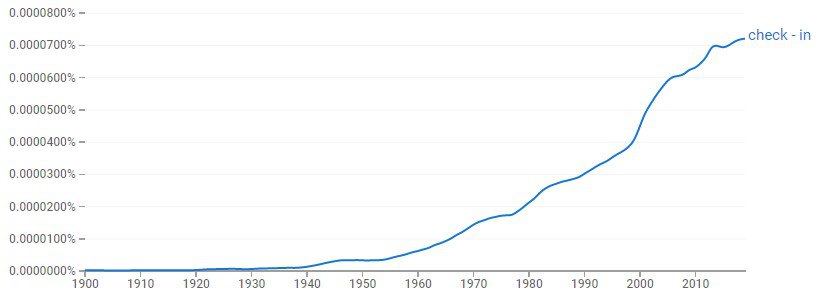Wondering when and where to use check in? Or is it check-in? Don’t worry; you aren’t the only one confused by this.
The use of these words both with and without a hyphen actually designates the versatility of the phrase in relation to parts of speech: it is either taking on an action or being used as a description of a place or time.
We explain the use of both check in and check-in with plenty of examples, so you know when and how to use the phrase both with, and without the hyphen present.
Check in or Check-in? When to Use Both
Check in, without a hyphen, is an action verb and denotes your action of checking in somewhere or, checking in on something. Check-in, with a hyphen, refers to either a place or time where you do your checking in and can be used either as a noun or adjective.
Which Came First? Origin of Use

The noun check-in, first appears in the early 1900s, most likely in reference to the hotel and travel industry. A check-in is an area where travelers pay for and get the information they need concerning their stay, or travel on a boat or railroad.
The word also can be used as an adjective to describe the time or place, such as check-in time or check-in desk.
It makes sense that the verb, to check in, followed on the heels of check-in to describe the action of using a designated check-in area. For example, you would go check in at the front desk, or would be checking in at 5 o’clock.
When to Use Check In
Check in, sans hyphen, is a verb phrase and is synonymous with registration upon arrival or confirmation of information. The term can also be used to check up on something, such as a date or time. It means that an action is taking place.
Examples
- She headed to the desk to check in to the hotel for her three-day business trip stay.
- He felt it was essential to check in on his parents since they had been recently ill.
- It was vital that they check in by 4 o’clock to secure their requested room.
When to Use Check-In
Check-in, as explained, can be used as either a phrasal adjective or a noun. This phrase provides information on where or when you will be registering upon arrival or meeting up with others. It also can describe an area designated as a spot specific for checking in.
Examples
- He hurried off the train to take advantage of the early check-in time.
- Check-in was located at the front desk in the hotel’s lobby.
- To reset the room key, he had to bring it back down to the check-in desk.
Let’s Review
Both check in, and check-in are widely used in relation to one another. Whereas check in describes the action of the phrase, check-in works to designate or tell the time or place.
If you keep getting them confused, consider that the meaning of the word check is a verb. When used as a stand-alone without a hyphen, it is used as an action word.
Once the hyphen is added, it becomes an adjective or a noun to describe objects used for this purpose or the act itself.
